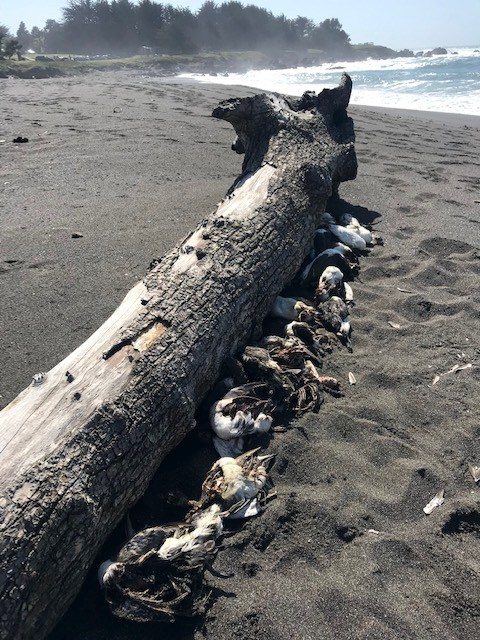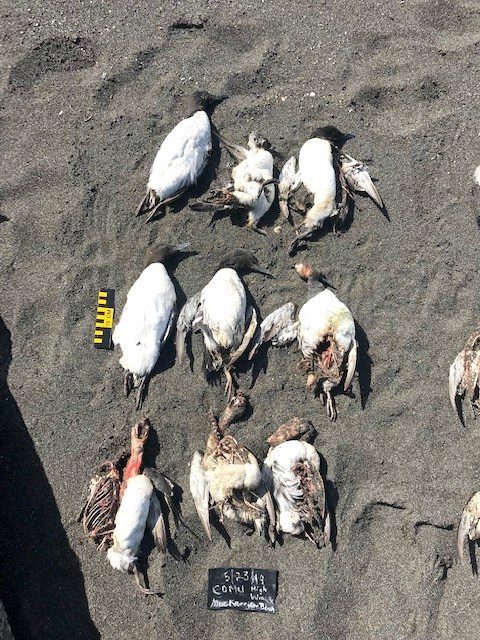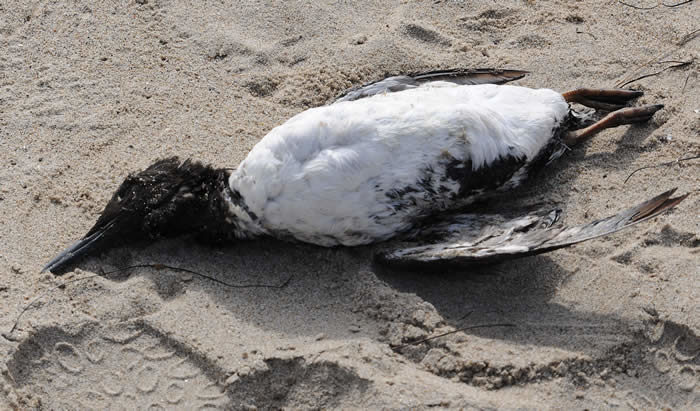Local wildlife observers say it's too early to tell what is causing the die-off.
The Common Murre looks a little like a penguin, but is more closely related to terns or gulls. It spends most of its time in the water. Murres can and do fly, but like penguins, they maneuver best in the water. Normally, the likelihood of a casual beachgoer seeing one ashore is slim.
More than 300 found

The man told Grimes he had counted 65 dead birds near his home in Inglenook. Grimes investigated and counted another 65 birds in the Ward Avenue area. She then reported the discovery to the Coastal Observation and Seabird Survey Team (COASST), a program run out of the University of Washington that trains local volunteers to survey beaches at least once a month and count and tag dead seabirds.
COASST put out a call to their volunteers on Wednesday night to mobilize for a "wreck," the term bird surveyors use to describe a mass mortality event. By 8 a.m., May 24, Grimes reported the count at 300 birds, primarily between Noyo Harbor and Seaside Beach.
Probably just a fraction
"The carcasses that wash ashore are a small fraction of the dead birds," said Prof. Julia Parrish, the executive director of COASST and associate dean of the College of the Environment at the University of Washington. "It could be 10 percent to 20 percent, depending on wave action and scavenger activity."
COASST and other volunteers, along with California State Parks personnel, are continuing the count, and the number of carcasses could rise.
According to Grimes, it's not clear what has caused the die-off. Murre die-offs in Alaska in recent years happened in fall and winter, and were tentatively attributed to disruptions in the food chain, with birds found emaciated.
Recent rains along the Mendocino Coast, Parrish said, could be a factor but are unlikely to be the sole cause.
"Murres are in the middle of their breeding season. They lay their eggs on high rocks above the wave line. They live their life on the open seas and are pretty scrappy," Parrish said. "Typically, you would find one dead carcass per kilometer this time of year. It's doubly alarming because this is the wrong time of year and the wrong species to be washing up on shore."
Volunteers overwhelmed
Grimes said she has seen the birds walking out of the water and perishing. Rescue teams have been unsuccessful in transporting the birds to the Humboldt Wildlife center as they are dying within an hour of collection.
Because the carcass numbers are so high, COASST volunteers are clipping wings to ensure birds are not counted twice. Typically, volunteers document each carcass and tag it, but there is no time for the normal process now.
Grimes, who also volunteers at COASST and the Audubon Society, has collected six birds and frozen them. They will be shipped to the U.S. Fish and Wildlife Service for a necropsy which, it is hoped, will shed light on the cause of the die-off.
"Seabirds have robust plumage to protect them from the cold and to seal a layer of air next to their bodies. This keeps them warm and dry. When birds are sick, they lose this ability and could be walking out of the water to get away from the cold," Grimes said.
She added that one of the birds she collected still had an egg intact, highlighting that this is breeding season, which typically runs from late May through June.

According to Terra Fuller, Senior Environmental Scientist for the California State Parks Coastal Region, the Common Murres that are washing up on Mendocino Beaches could be from an established colony off the Mendocino Headlands. The Headlands is part of the Coastal National Monument and under Bureau of Land Management jurisdiction. BLM did not immediately respond to an inquiry whether it knows if the birds are from that colony, and if the colony is being monitored.
"The lack of northwest wind in May reduced upwelling and the cold water that feeds the ecosystem," Fuller said, noting that any explanation of causes now is speculative. "The birds, which typically feed well offshore, may have moved their feeding closer to shore where the upwelling was still in effect. If that is the case, they may have been caught in the storm."
Fuller went on to say that Parrish and COASST are the experts on collecting data and determining cause.
COASST conducts surveys from Elk in Mendocino County to the Canadian border. Beach Watch surveys the coast from Elk to Monterey. COASST has been in contact with Beach Watch and they have not found an unusual number of dead birds in their area, indicating the die-off is concentrated in Mendocino County at this time.
Among the many questions raised: is this die-off tied to El Niño, climate change, deforestation of the kelp or warm waters off the coast? Is there a toxic algae bloom; did the birds eat fish that were full of toxins?
According to Grimes and Parrish, it is too soon to know and only time and testing will shed light on the death of Common Murres in Mendocino County.
What to do
Anyone who encounters dead or dying birds should leave them be and contact one of the organizations involved in tracking the die-off, although it may only be possible to leave a message over the Memorial Day weekend. California State Parks is asking the public to call the CalTips hotline at 1-888-334-CALTIP if they see live birds struggling in the surf.
Common Murres cannot walk on sand and once they reach the beach they will die. The hotline goes to both State Parks and the California Department of Fish and Wildlife and whoever is closest will respond. Live birds will be transported to Humboldt Wildlife Refuge.
For concentrations of dead birds, leave a voice mail at 707-937-4463 and volunteers from The Coastal Observation and Seabird Survey Team will respond.




Hold your heads in shame.